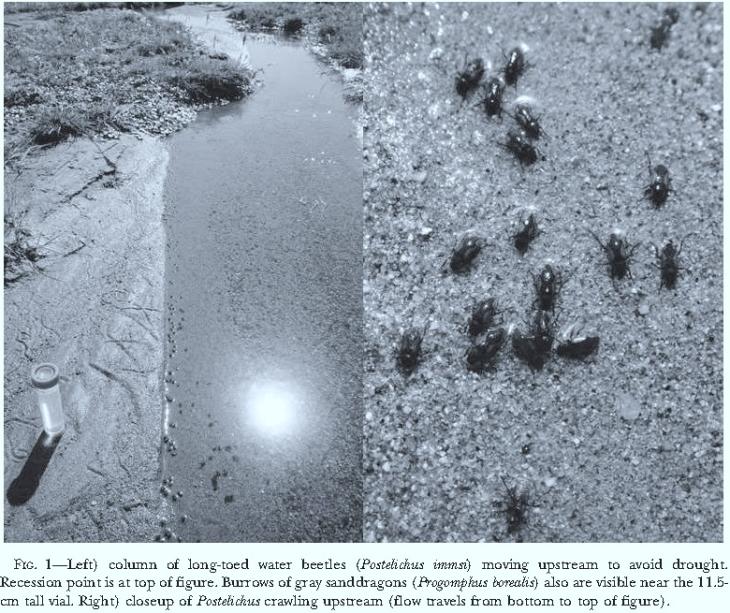Flood escape behaviors: videos and more info
Flood escape behaviors: videos and more info
Flood escape behavior in Abedus herberti, triggered by simulated rainfall
After experiencing 20 to 40 minutes of intense monsoon rainfall, giant water bugs in desert streams become "robots" with the singular goal of crawling away from the active stream channel and hiding from the coming flash floods in protected riparian areas. In this video we triggered flood escape behavior in an adult Abedus herberti using simulated monsoon rainfall (stream water recirculated with a pump). Once the behavior is triggered, individuals seek the steepest route away from the stream, and continue moving so long as raindrops hit their dorsal surface (from our watering can, in this case). While crawling, these usually-skittish creatures ignore the presence of humans and continue their slow march to safety. This individual moved about 30m from the stream until it climbed a yucca plant where our "rainfall" could no longer reach it. In natural situations, this flightless species usually returns to the stream within 24h after the flood has subsided. (video: Wade Sherbrooke)
Flood escape behavior in Abedus herberti during a rainstorm
This shows an individual climbing a vertical granite wall during a monsoon rainstorm in Chulo Canyon, Mule Mtns. Arizona. It had been raining hard for over 20 minutes; the stream is beginning to swell from rainfall but a flood has not yet occurred. (video: Dave Lytle; thanks to Kathy Wertz for access to Chulo Canyon)
Lethocerus medius flood escape behavior
It turns out that other belostomatid species, perhaps the majority of them, are able to use rainfall as a signal to leave aquatic habitats. However, for most species rainfall is simply a signal that the rainy season has begun, and it is time to fly away to seasonal rain pools where reproduction occurs in food-rich and predator-free space. This video shows an adult Lethocerus medius, a distant relative of Abedus, crawling out of the water in response to simulated rainfall. Unlike the flightless Abedus, however, this species waits until nightfall and then readies itself for flight by pumping hemolymph into its wing muscles, which likely have not been used for most of the year. This species flies in search of rain pools in the desert flats, to reproduce and feed on spadefoot toad tadpoles and other prey. (video: Lytle lab)
A relatively mild flash flood on Cave Creek, Chiricahua Mtns. Arizona
Giant water bugs live in streams that span a range of flow regimes. Some streams experience multiple extreme floods each year (see any desert flash flood video posted on the Web) to none at all in the case of small spring-fed habitats. This video shows a relatively small flood, but it illustrates the suddenness of these events, as well as the fact that they sometimes occur without prior rainfall cues. We have found that flood escape behavior has evolved to different states across populations of Abedus, depending on the average frequency and severity of flash floods; and in the case of populations where no floods occur, the behavior has evolved away completely. (video: Mike Bogan)
Flood escape behavior in other organisms
Many other aquatic insect species appear to possess some ability to use rainfall as a cue to leave streams, thereby escaping floods. Lytle & White 2007 JIB present experiments showing this behavior is common in Hemiptera and also occurs in other insect groups. Some insect groups such as Coleoptera may use cues other than rainfall, such as drops in barometric pressure associated with rainstorms, but conclusive experiments remain to be done. Still other insects have behaviors that allow them to find the active river channel following large flood events. The images below from Lytle et al. 2008 SW Nat. show aquatic beetles and dragonfly larve moving upstream as a river side channel dries out. This kind of "adaptation to flow variability" could allow individuals to survive being washed into side channels that dry as floods recede.

(photo: Julian Olden)